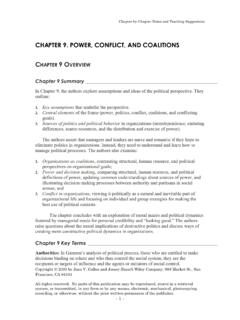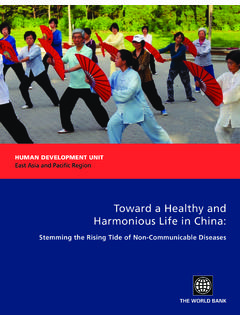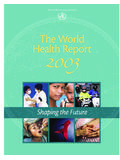Transcription of CHAPTER 1. INTRODUCTION: THE POWER OF …
1 CHAPTER -by- CHAPTER Notes and Teaching Suggestions CHAPTER 1. introduction : THE POWER OF REFRAMING. CHAPTER 1 OVERVIEW. CHAPTER 1 Summary _____. In CHAPTER 1, the authors introduce the concepts of reframing and frames. They propose four basic frames, or lenses, for strengthening managerial diagnosis and action: a structural frame, a human resource frame, a political frame, and a symbolic frame. (The four frames are summarized in Table below.). The authors assert that managers and leaders often bring too few ideas and too many habitual responses to organizational problems and challenges. They rely on a limited cognitive perspective to make sense of the world and remain blind to other options. They delude themselves in thinking theirs is the only way to handle a particular problem. Such thinking hinders managerial effectiveness and abilities to understand and respond to the complexities of life in today's turbulent world. Successful managers and leaders require more comprehensive perspectives.
2 They need multiple lenses and skills in reframing looking at old problems in a new light, as well as confronting new challenges with different tools and reactions. Reframing expands understandings, responses, timing, and styles that managers apply to problems. It helps them translate managerial good intentions into effective action. Copyright 2003 by Joan V. Gallos and Jossey-Bass/A Wiley Company, 989 Market St., San Francisco, CA 94103. All rights reserved. No parts of this publication may be reproduced, stored in a retrieval system, or transmitted, in any form or by any means, electronic, mechanical, photocopying, recording, or otherwise, without the prior written permission of the publisher. -1- CHAPTER -by- CHAPTER Notes and Teaching Suggestions Table The Four Frames Summarized Frame Disciplinary Frame Emphasis Key Concepts Key Frame Roots Processes Structural Sociology Rationality, Rules, roles, Division of labor formal roles and goals, policies, and relationships technology, coordination of environment individual activities Human Social and The fit between Needs, skills, Tailoring the resource organization people and the relationships organization to psychology organization meet individual needs Political Political science The allocation POWER , conflict, Bargaining, of POWER and competition, negotiation, scarce positive politics coalition resources building Symbolic Social and Organization as Culture, ritual, Creating and cultural tribe, theater, or ceremony, promoting a anthropology carnival stories, heroes common vision.
3 And heroines, attending to myths, symbols, the meaning of metaphors, events; devising charisma relevant rituals, ceremonies, and symbols CHAPTER 1 Key Terms _____. Frame: Cognitive lens on the world that affects what we see and what it means. Reframing: Viewing situations from multiple perspectives. Structural frame: A frame for viewing organizations that focuses on the architecture of organization the design of units and sub-units, rules and roles, goals and policies that shape and channel decisions and activities. Human resource frame: A frame for viewing organizations that emphasizes that management requires an understanding of people, with their strengths and foibles, reason and emotion, desires and fears. Political frame: A frame for viewing organizations that sees organizations as competitive arenas characterized by scarce resources, competing interests and struggles for POWER and advantage. Symbolic frame: A frame for viewing organizations that focuses on issues of meaning and faith.
4 Copyright 2003 by Joan V. Gallos and Jossey-Bass/A Wiley Company, 989 Market St., San Francisco, CA 94103. All rights reserved. No parts of this publication may be reproduced, stored in a retrieval system, or transmitted, in any form or by any means, electronic, mechanical, photocopying, recording, or otherwise, without the prior written permission of the publisher. -2- CHAPTER -by- CHAPTER Notes and Teaching Suggestions CHAPTER 1 Major Case Examples _____. Ken Lay and Jeffrey Skilling of Enron Executive browsing in the management section of a bookstore Conflict between the Federal Bureau of Investigation and the Central Intelligence Agency SUGGESTIONS FOR TEACHING CHAPTER 1. The central ideas in CHAPTER 1 revolve around people's need to recognize their limited views on everyday life and to expand the ways in which they make sense out of their world by viewing organizational events through multiple lenses. In teaching these central ideas, instructors can focus on: 1.
5 Understanding the process of reframing. 2. Engaging in self-diagnosis and exploring personal theories. 3. Examining the content of the four frames. Each of the approaches above suggests its own teaching methods, some of which are described in the sections that follow. In addition, student exercises keyed to the approaches appear in Student Exercises for CHAPTER 1, beginning on page 10. CHAPTER 1: A Focus on Reframing _____. Reframing is a difficult concept for many students to grasp, especially concrete thinkers or people who, for developmental reasons, want the one right answer. Reframing demands a tolerance for ambiguity, an appreciation of how reality is socially constructed, and skills in relative thinking developmentally sophisticated capacities. For these reasons, instructors should not assume that students understand the concept of reframing from reading alone. They may want to use this CHAPTER as a way of both offering students opportunities to experience multiple perspectives on the same event (reframing) and diagnosing where their students are.
6 The following resources may be of help. CHAPTER 1: Films or Videos Focusing on Reframing Movies offer one way to explore reframing issues. Kurosawa's classic Rashomon, in which four witnesses tell four different accounts of a murder and rape, lends itself to discussion about the complex motives of the four storytellers and the implications of their tales. This leads to explorations about Copyright 2003 by Joan V. Gallos and Jossey-Bass/A Wiley Company, 989 Market St., San Francisco, CA 94103. All rights reserved. No parts of this publication may be reproduced, stored in a retrieval system, or transmitted, in any form or by any means, electronic, mechanical, photocopying, recording, or otherwise, without the prior written permission of the publisher. -3- CHAPTER -by- CHAPTER Notes and Teaching Suggestions personal interpretations of truth and acknowledgment of the need for multiple frames and skills in reframing. (Note: Rashomon is a complex film. It is slow-moving and in black and white with Japanese subtitles.)
7 Instructors will want to gauge whether this is right for their students.). The classic training film Perception: The Tragedy of the Friendly Breakfast (Salenger) takes a humorous look at similar issues when three eyewitnesses offer their stories of what really happened when a gunshot ruined an otherwise friendly meal. This film is perfect for exploring how perception influences personal interpretations of events and how beliefs influence perception. Hope and Glory is World War II as seen through the eyes of a young British boy. Like Rashomon, the film is perfect for discussions about the personal meaning of social events and the possible motivations for constructing personal frames. This film is less complex than Rashomon and lacks the explicit contrasts of the four different stores. Malle's My Dinner with Andr shows a conversation between two friends with different worldviews and assumptions about love, death, art, and the quest for self- fulfillment.
8 Exploring the depth of and reasons for these differences and their implications for the men's friendship leads to discussion of the POWER and social consequences of contrasting frames. Additional film possibilities include the following, all of which illustrate well the social construction of reality and the ways in which different personal and cultural perspectives frame the meaning of events: Rude Awakening. Two hippies return to New York City after twenty years in a Central American commune to find that people are no longer out protesting to save the world. Austin Powers. A hip secret agent of the cold war era is frozen until needed and returned to action in the late 1990s. Bananas. Woody Allen portrays a New Yorker turned Central American revolutionary. My Big Fat Greek Wedding. Toula, from a large, intense, Greek-American family falls in love with and marries Ian, who hails from a restrained, upper-crust, Anglo- Saxon background. The parents on each side frame almost everything differently (as in the scene when Ian's parents struggle to make sense of a party hosted by Toula's parents).
9 Another variation on the theme of boy meets future in-laws, Meet the Parents, raises similar issues. Copyright 2003 by Joan V. Gallos and Jossey-Bass/A Wiley Company, 989 Market St., San Francisco, CA 94103. All rights reserved. No parts of this publication may be reproduced, stored in a retrieval system, or transmitted, in any form or by any means, electronic, mechanical, photocopying, recording, or otherwise, without the prior written permission of the publisher. -4- CHAPTER -by- CHAPTER Notes and Teaching Suggestions The Matrix. Beyond the combat and special effects lies a film about framing. It teaches that virtual reality is real if you think it is and that if you control people's framing, you control their reality. Memento. The central character tries to solve a mystery despite severe short-term memory deficiencies. The film links framing and memory it is almost impossible to understand the present and plan for the future without remembering and making sense of the past.
10 (Memento also creates a framing challenge for viewers because it often runs time backwards. Many find the film disorienting and confusing until they begin to understand what they are witnessing.). An alternative is to show a movie excerpt in which the central characters illustrate reframing in action. Two such scenes from the movies Dead Poets Society are (1) the scene in which Professor Keating has students stand on his desk to learn to see the world from a different perspective and (2) the scene in which he asks students to rip the analytic introduction from their poetry books. In The Karate Kid, there is a scene in which Mr. Miyagi shows Daniel how his painting, sanding, and car waxing ( Wax on wax off ) are not simply household tasks but also serve as critical training for karate. In A Beautiful Mind, there is a classroom scene in which Professor John Nash, distracted by construction noise outside, closes a window. A female student gets up, opens the window, and talks to the workers to get them to reduce the noise level.









